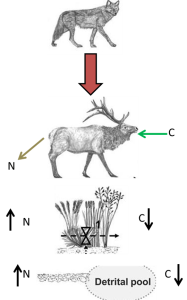| Project duration: | 2022-2027 |
|---|---|
| Project status: | Active |
| Project leader: | Prof. dr hab. Krzysztof Schmidt |
| Project co-investigators: |
Dr Elizabeth le Roux (Aarhus University, Denmark) Dr hab. Dries P. J. Kuijper Dr Marcin Churski Dr Kuba Bubnicki Dr hab. Marta Koodziej-Sobocińska Dr. Katarzyna Janik-Superson (University of Lodz, Poland) Dr. Dominik Strapagiel (University of Lodz, Poland) Prof. Rupert Palme (University of Veterinary Medicine, Austria) Msc María Losada Cuquejo Msc Cecilia Tomasulo Msc Srivats Chari |
Predation plays a key role in regulating ecosystem processes by both consuming prey and inducing non-consumptive behavioral and physiological changes among prey animals. In recent years, attention has been paid to the possibility of both mechanisms influencing the circulation of elements in the environment, especially the circulation and accumulation of carbon in the ecosystem. The idea of the project is based on the concept of the “general stress paradigm” (GSP), which postulates that animals subjected to stress related to the risk of predation should relocate resources used for growth and reproduction (protein-requiring processes) to emergency functions (processes requiring high-energy carbohydrates). GSP assumes that the stress-induced gluconeogenesis causes the breakdown of proteins into glucose, which is deposited in the tissues, and nitrogen, which is excreted into the environment. At the same time, in response to increased risk and the need to compensate for high energy demands, animals should select for food rich in high-energy carbohydrates from the environment to increase the effectiveness of defense functions (e.g. flight). However, these assumptions have not been tested empirically in the system of interactions between large carnivorous and herbivorous mammals. The aim of this project is to investigate the impact of the risk associated with the presence of large predatory mammals – wolves and lynxes – and the potential stress it causes in their prey – ungulates (red deer and roe deer) – on the functioning of the temperate forest ecosystem. We will test the hypothesis that if the stress has a significant effect on the physiology of the prey, it should have a measurable effect on the chemical composition of their faeces, as well as the environment (plants, litter, soil), including, in particular, the proportional share of carbon and nitrogen.

We intend to carry out the project in the Białowieża Primeval Forest, where previous studies have shown a large spatial differentiation in the level of predation risk at the macro-habitat (the entire forest complex) and micro-habitat scale (between the forest gaps and closed canopy), as well as complex interactions between ungulates and large carnivores that affect the perception of predation risk by ungulates, enabling them for flexible behavioral responses to stress. The research will consist mainly of the collection and analysis of biological samples containing information on: the level of stress (concentration of glucocorticoid metabolites in the faeces) of red deer and roe deer, food selectivity (in terms of species and chemical composition – the content and proportion of carbon to nitrogen, carbohydrates and protein), as well as measurements of the chemical composition of plant, litter, soil and urine samples of deer, and monitoring of animal activity with the use of camera traps in places with varying levels of predation risk.
Collecting data for analyses of chemical composition of plants, litter and soil will be based on excluding the sampling plots from the pressure of large herbivores by constructing fenced 4 x 4 x 2 m exclosures in the zones of the Białowieża Forest differing in levels of predation risk, and their comparison with analogous data from unfenced plots. Due to the importance of the microhabitat structure in the interactions between predators and ungulates, the sampling plots will be located both within forest gaps and in a dense forest. Sampling is planned considering the possible influence of ungulates’ foraging during the growing season and the effects of their cumulative impact over long-term periods.
Explaining the relationship between the level of predation risk, stress response, food selectivity of large herbivores (nutritional content of food – carbon to nitrogen ratio), species and chemical composition of vegetation available and remaining in the environment as a result of ungulates’ foraging, and the proportion of carbon and nitrogen in litter and soil will allow to reveal the magnitude of the effect the carnivores have on the accumulation and circulation of carbon in the environment. Project outcomes should enable understanding the multifunctional role of large carnivores play in shaping forest ecosystems. Understanding this phenomenon is extremely important given that most of the world’s carnivore species have experienced a dramatic decline in numbers and ranges over the past two hundred years, but also because simplifying the food web by eliminating them leads to the degradation of entire ecosystems.